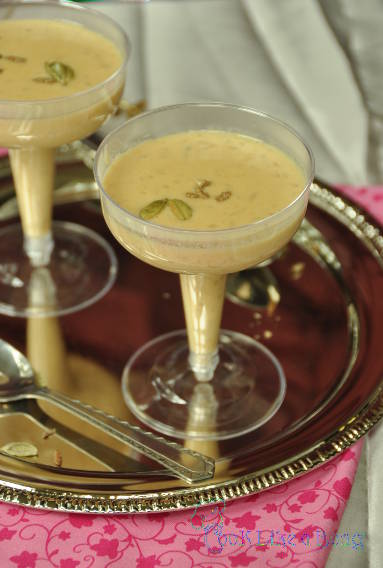When we asked Sudeshna, author of the food blog Cook like a Bong to test our Saucepan with built-in strainer she had a wonderful idea for a recipe she wanted to try and was kind enough to allow us to share her post on our blog. She decided to make a favorite Bengali dessert: Gurer Payesh – Rice Pudding with Jaggery

This is what she says about this delicious dessert and how she made it using the GitaDini Saucepan:
Payesh or rice pudding is one of the most common desserts that you’ll see getting prepared in every Bengali household. It is one of the most authentic Bengali desserts. Payesh is offered as bhog during pujas, and also as a sweet treat for every birthday. Payesh has a special place in the menu to bid farewell to your loved ones.
A Bengali occasion without payesh is yet to be heard of. Rice or vermicelli is the two main options for making payesh. The short grained scented gobindobhog chal is ideal for preparing payesh, the scent from the rice adds a special flavor to the whole preparation. The vermicelli or simayer payesh is a quick and easier version.
Though sugar is used as the main sweetener, during winter the just-in-market jaggery, nalen gur adds a wintery treat to payesh.
Gurer Payesh – Rice Pudding with Jaggery
Course: DessertCuisine: IndianDifficulty: Medium8-10
servings5
minutes1
hourIngredients
1 quart milk
1/4 cup scented rice
1/4 cup jaggery
3-4 cloves
1 teaspoon ghee
Directions
- Boil the milk in low flame till it reduces to half the volume. It would take about 30 mins.
- In the meantime mix the rice with ghee
- Pour out a little milk in a bowl and add the jaggery. Press the jaggery with the back of a spoon, so that it dissolves in the milk
- Add the rice to the milk, and let it boil over low flame till the rice is cooked.
- Pour the jaggery mixed milk into the vessel and boil for 2-3 minutes more. Garnish with the crushed cloves.
- Serve hot or cold
Notes
- Mixing ghee before adding the rice to milk lets the rice stay separated.
- Always test the jaggery by mixing it with little milk before adding it to the payesh.
- At times the jaggery clumps the milk, making the payesh a clumpy mess.

Here’s Sudeshna’s review of the GitaDini saucepan:
Gitadini sent me a 2 quart saucepan to review. The saucepan has built-in strainer and is ideal for making tea, especially for people like me who keep on loosing the tea strainer. The built-in strainer allows you to pour tea into the cups directly without a tea strainer. But, I wanted to use the strainer for something better and preparing payesh in it was the best option I could think of. The handle is sturdy and has an extra padding for better comfort and insulation. While, making payesh you should be extra careful as the rice tends to get stuck to the bottom of the pan, but this saucepan worked wonders. And, the best part is it’s easy to clean and is dishwasher safe. I’m planning to prepare soups in it too and I think it would be great for deep frying.
Thanks, Sudeshna for sharing this yummi sounding dessert with us!
